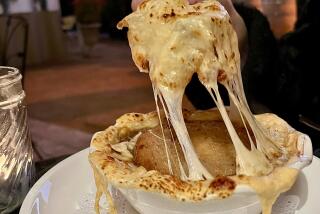SOUP : Chowder: A Stand-Up Kind of Soup
- Share via
Chowder for breakfast, and chowder for dinner, and chowder for supper. . . . --Herman Melville, ‘Moby Dick”
In name and form, chowder is a uniquely American dish, usually a fish or shellfish soup thick enough to stand a spoon in--a hearty potful of basic flavors in the Yankee vernacular. On that, nearly everyone who knows chowder will agree.
But what exactly defines a chowder? How does it differ from other seafood soups and stews? And, incidentally, where did its trenchermanly name--”chowder” sounds like a mouthful, like “chow” augmented--originate?
The name first: “Chowder” seems to come from the French word “ chaudiere ,” which usually means “pot” or “caldron.” Never mind that a chaudiere isn’t a cooking pot at all, but a copper boiler (of a steam-engine, for instance) or, in French Canada, a bucket. Never mind that chowder is primarily a dish of central New England, where Italian and Portuguese culinary influences are far stronger than French. Never mind that it isn’t particularly French in character. Nobody has come up with a better derivation that I know of--though the Oxford English Dictionary does give “chowder” as a dialect variation of an old Cornwall or Devonshire word jowter , meaning a fish peddler--so let’s just let it stew right there.
Now, what’s in a chowder and what isn’t? One essential ingredient, strangely enough, seems to be salt pork--the salted raw pork the French call petit sale. I’ve never seen an authentic chowder recipe without it. (This is perhaps an argument in favor of its French ancestry after all.) Other than that, it almost always involves milk as its principal liquid (with one important exception; see below), and it almost always includes potatoes, apparently both for bulk and to thicken the soup with their excess starch. Some sort of salted cracker is often served with chowder as a condiment.
And, of course, chowder is almost always made with seafood--these days most commonly clams, but also oysters, mussels, salmon, lobster, crab or almost any kind of white-fleshed fish, particularly cod. There is also one well-known non-piscatorial chowder, made with corn. (Sometimes corn and crab meat are combined.) I’ve even heard rumors of chicken chowder, though I’ve never run across the beast.
Beyond these ingredients, it can safely be stated that chowder is always a full-bodied soup and always contains recognizable chunks of its constituent ingredients (unlike, say, a bisque, in which almost everything is pureed). It is thus appropriate fare for fall, winter and the early, still-chilly spring months.
Herman Melville, incidentally, sketched a recipe for clam chowder, involving butter but not milk (at least, not specifically, though it could have been such an accepted part of the recipe he felt it didn’t need to be mentioned), when he wrote of the dish as served at the Try Pots chowder house in Nantucket, Mass., in “Moby Dick” (1851): “It was made of small juicy clams, scarcely bigger than hazelnuts, mixed with pounded ship biscuits, and salted pork cut up into little flakes, the whole enriched with butter, and plentifully seasoned with pepper and salt.”
The central schism in chowderdom today is between Boston or New England clam chowder on one hand and Manhattan clam chowder on the other. The Manhattan variety, which is the only traditional chowder made with tomatoes and their juice in place of milk, seems more closely related to Mediterranean fish soups than to its New England cousin (though it lacks that quintessential Mediterranean flavoring, garlic). Many chowder-lovers refuse to accept it as a chowder at all, in fact. “A Yankee reared on the milk chowder of his native shore,” the celebrated early 20th-Century New York restaurateur George Rector once noted, “regards the reddish, milk-less Manhattan breed about the same way a brewer from Pilsen would regard near-beer.” On the other hand, adds Rector, a properly made Manhattan chowder can “do battle with any chowder that ever saw Cape Cod.”
The good thing about being here in California, nearly 3,000 miles from either Manhattan or New England, is that we can quite happily enjoy both varieties, and variations on the theme as well, without inducing the least hint of cultural qualm.
NEW ENGLAND CLAM CHOWDER
1 (3-ounce) piece salt pork or bacon
1 onion, very finely chopped
2 cups water
3 dozen clams, rinsed thoroughly and shucked
2 medium potatoes, peeled and diced
4 cups milk
Salt
White pepper
Oyster crackers, sea biscuits, or saltine-type crackers, optional
Cut salt pork into small pieces. Place in large, heavy stock pot (preferably cast iron) over very low heat. Cook until fat lightly coats bottom of pot. Add onion. Continue cooking over low heat until onion turns golden.
Bring water to boil in separate pot. Meanwhile, rinse clams and chop coarsely.
Add clams to stock pot with onions. Add potatoes, then quickly add boiling water. Stir well and bring to boil again. Reduce heat to low, cover pot and cook until potatoes are done, about 15 minutes.
While chowder is cooking, warm milk in separate pot over low heat, being careful not to let it burn. When potatoes are done, stir warm milk into chowder and season to taste with salt and white pepper.
Serve chowder in individual bowls with oyster crackers. Makes 6 servings.
Each serving contains about:
289 calories; 359 mg sodium; 50 mg cholesterol; 17 grams fat; 20 grams carbohydrates; 13 grams protein; 0.30 gram fiber.
Note : If salt pork is briny or caked with salt, soak in pan in room temperature water 4 to 6 hours before using.
*
This is an adaptation of George Rector’s recipe from the 1930s. Contemporary Manhattan clam chowder usually includes celery, but rarely turnips.
MANHATTAN CLAM CHOWDER
1 (3-ounce) piece salt pork or bacon, finely diced
2 onions, very finely chopped
2 potatoes, peeled and diced
2 carrots, peeled and diced
2 cups strained tomato pulp from 4 medium tomatoes finely chopped or 1 (35-ounce) can
1 turnip, peeled and diced
3 sprigs parsley, finely chopped
5 cups fish or vegetable stock
Salt
Freshly ground pepper
1 teaspoon ground dried thyme
30 clams, rinsed thoroughly and shucked
Caraway seeds, optional
Slowly cook salt pork in heavy stock pot over very low heat until fat coats bottom of pot and is well browned. Add onions. Cook about 15 minutes.
Add potatoes, carrots, tomato pulp, turnip, parsley and stock to pot. Stir well over low heat. Season to taste with salt and pepper. Stir in thyme. Cover and simmer 15 minutes.
Meanwhile, rinse clams and chop coarsely. When vegetables have simmered 15 minutes, add clams to pot. Continue cooking over low heat, covered, 25 minutes more.
When ready to serve chowder, add caraway seeds to taste over top of each bowl. Makes 6 servings.
Each serving contains about:
287 calories; 345 mg sodium; 27 mg cholesterol; 13 grams fat; 35 grams carbohydrates; 11 grams protein; 2.77 grams fiber.
*
This recipe is adapted from Alessandro Filippini, chef at Delmonico’s in New York, in his book “The Table: How to Buy Food, How to Cook It, and How to Serve It,” published in 1889.
OLD-FASHIONED FISH CHOWDER
1 quart veal or chicken stock
1 pound fresh codfish or other firm white-fleshed fish, cut into 2 pieces
Salt
Freshly ground pepper
2 tablespoons butter
1 ounce salt pork or bacon, finely diced
1 onion, very thinly sliced
1 tablespoon flour
2 potatoes, peeled and diced
2 cups cold milk
3 to 4 sprigs parsley, trimmed and very finely chopped
Place stock in large stock pot. Add fish, then cover and bring to boil. Uncover partially and reduce heat. Season lightly to taste with salt and pepper. Simmer 20 minutes.
Meanwhile, melt butter in skillet. Add salt pork and onion. Cook on low heat about 5 minutes. Dust pan with flour. Stir well. Cook 2 to 3 more minutes, being careful not to let flour brown. Remove from heat.
Strain stock into bowl, setting fish aside to cool. Add bit of stock to onion mixture. Return skillet to heat and deglaze. Return remaining stock to pot. Add deglazed onion mixture and potatoes to pot. Bring to boil. Reduce heat and simmer, uncovered, about 15 minutes.
Meanwhile, remove bones and skin from fish and flake into pieces. Return fish to stock pot. Simmer 5 minutes longer. Add milk to pot. Adjust seasonings to taste. Stir well. Bring soup to boil. Then immediately remove from heat. Sprinkle with parsley and serve. Makes 6 servings.
Each serving contains about:
256 calories; 769 mg sodium; 54 mg cholesterol; 12 grams fat; 16 grams carbohydrates; 21 grams protein; 0.23 gram fiber.
*
This is an authentic Upstate New York farm country recipe, dating from the 1940s, though it’s probably much older in basic form. The original ‘40s version calls for canned corn--not very “country” but very ‘40s indeed.
CORN CHOWDER
1 (3-ounce) piece salt pork or bacon, finely diced
2 onions, very finely chopped
2 potatoes, peeled and cut into large dice
2 (17-ounce) cans cream-style corn or 6 ears fresh corn, husked and rinsed
4 to 6 cups milk
Salt
Freshly ground pepper
Oyster crackers, sea biscuits, or saltine-type crackers, optional
Slowly cook salt pork in heavy stock pot over very low heat until rendered fat is well browned. Add onions and potatoes and continue cooking, uncovered, about 15 minutes.
If using canned corn, add to pot. Then add 4 cups milk to pot.
If using fresh corn, cut kernels from cobs with sharp knife and coarsely chop half of kernels with knife or in food processor. Mix well with 2 cups milk. Add milk-corn mixture and 4 more cups milk to pot.
Cover pot and cook over low heat at least 30 minutes or until quite hot, stirring frequently. Do not let chowder boil. Just before serving, season to taste with salt and pepper.
Serve chowder in individual bowls with oyster crackers. Makes 6 servings.
Each serving contains about:
343 calories; 348 mg sodium; 34 mg cholesterol; 18 grams fat; 38 grams carbohydrates; 10 grams protein; 1.09 grams fiber.
Clam chowder soup tureen, bowl and plate courtesy of Clouds Folsom, Folsom, Calif.
New England clam chowder soup bowls courtesy of Bristol Farms Cook ‘N’ Things.
Food styling by Donna Deane and Mayi Brady
More to Read
Eat your way across L.A.
Get our weekly Tasting Notes newsletter for reviews, news and more.
You may occasionally receive promotional content from the Los Angeles Times.








